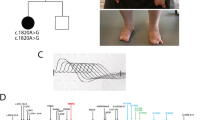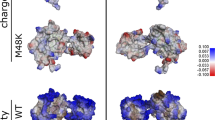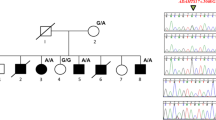Abstract
Familial digital arthropathy-brachydactyly (FDAB) is a dominantly inherited condition that is characterized by aggressive osteoarthropathy of the fingers and toes and consequent shortening of the middle and distal phalanges1. Here we show in three unrelated families that FDAB is caused by mutations encoding p.Gly270Val, p.Arg271Pro and p.Phe273Leu substitutions in the intracellular ankyrin-repeat domain of the cation channel TRPV4. Functional testing of mutant TRPV4 in HEK-293 cells showed that the mutant proteins have poor cell-surface localization. Calcium influx in response to the synthetic TRPV4 agonists GSK1016790A and 4αPDD was significantly reduced, and mutant channels did not respond to hypotonic stress. Others have shown that gain-of-function TRPV4 mutations cause skeletal dysplasias and peripheral neuropathies2,3,4,5,6,7,8,9,10,11. Our data indicate that TRPV4 mutations that reduce channel activity cause a third phenotype, inherited osteoarthropathy, and show the importance of TRPV4 activity in articular cartilage homeostasis. Our data raise the possibility that TRPV4 may also have a role in age- or injury-related osteoarthritis.
This is a preview of subscription content, access via your institution
Access options
Subscribe to this journal
Receive 12 print issues and online access
$209.00 per year
only $17.42 per issue
Buy this article
- Purchase on Springer Link
- Instant access to full article PDF
Prices may be subject to local taxes which are calculated during checkout






Similar content being viewed by others
Accession codes
References
Amor, D.J. et al. Familial digital arthropathy-brachydactyly. Am. J. Med. Genet. 108, 235–240 (2002).
Camacho, N. et al. Dominant TRPV4 mutations in nonlethal and lethal metatropic dysplasia. Am. J. Med. Genet. A. 152A, 1169–1177 (2010).
Rock, M.J. et al. Gain-of-function mutations in TRPV4 cause autosomal dominant brachyolmia. Nat. Genet. 40, 999–1003 (2008).
Krakow, D. et al. Mutations in the gene encoding the calcium-permeable ion channel TRPV4 produce spondylometaphyseal dysplasia, Kozlowski type and metatropic dysplasia. Am. J. Hum. Genet. 84, 307–315 (2009).
Deng, H.X. et al. Scapuloperoneal spinal muscular atrophy and CMT2C are allelic disorders caused by alterations in TRPV4. Nat. Genet. 42, 165–169 (2009).
Landoure, G. et al. Mutations in TRPV4 cause Charcot-Marie-Tooth disease type 2C. Nat. Genet. 42, 170–174 (2009).
Nishimura, G. et al. Spondylo-epiphyseal dysplasia, Maroteaux type (pseudo-Morquio syndrome type 2), and parastremmatic dysplasia are caused by TRPV4 mutations. Am. J. Med. Genet. A. 152A, 1443–1449 (2010).
Auer-Grumbach, M. et al. Alterations in the ankyrin domain of TRPV4 cause congenital distal SMA, scapuloperoneal SMA and HMSN2C. Nat. Genet. 42, 160–164 (2009).
Klein, C.J. et al. TRPV4 mutations and cytotoxic hypercalcemia in axonal Charcot-Marie-Tooth neuropathies. Neurology 76, 887–894 (2011).
Chen, D.H. et al. CMT2C with vocal cord paresis associated with short stature and mutations in the TRPV4 gene. Neurology 75, 1968–1975 (2010).
Zimon, M. et al. Dominant mutations in the cation channel gene transient receptor potential vanilloid 4 cause an unusual spectrum of neuropathies. Brain 133, 1798–1809 (2010).
Cameron, T.L., Belluoccio, D., Farlie, P.G., Brachvogel, B. & Bateman, J.F. Global comparative transcriptome analysis of cartilage formation in vivo. BMC Dev. Biol. 9–20 (2009).
Hellwig, N., Albrecht, N., Harteneck, C., Schultz, G. & Schaefer, M. Homo- and heteromeric assembly of TRPV channel subunits. J. Cell Sci. 118, 917–928 (2005).
Li, J., Mahajan, A. & Tsai, M.D. Ankyrin repeat: a unique motif mediating protein-protein interactions. Biochemistry 45, 15168–15178 (2006).
Strotmann, R., Harteneck, C., Nunnenmacher, K., Schultz, G. & Plant, T.D. OTRPC4, a nonselective cation channel that confers sensitivity to extracellular osmolarity. Nat. Cell Biol. 2, 695–702 (2000).
Watanabe, H. et al. Heat-evoked activation of TRPV4 channels in a HEK293 cell expression system and in native mouse aorta endothelial cells. J. Biol. Chem. 277, 47044–47051 (2002).
Gao, X., Wu, L. & O'Neil, R.G. Temperature-modulated diversity of TRPV4 channel gating: activation by physical stresses and phorbol ester derivatives through protein kinase C-dependent and -independent pathways. J. Biol. Chem. 278, 27129–27137 (2003).
Watanabe, H. et al. Activation of TRPV4 channels (hVRL-2/mTRP12) by phorbol derivatives. J. Biol. Chem. 277, 13569–13577 (2002).
Thorneloe, K.S. et al. N-((1S)-1-{[4-((2S)-2-{[(2,4-dichlorophenyl)sulfonyl]amino}-3-hydroxypropanoyl)-1-piperazinyl]carbonyl}-3-methylbutyl)-1-benzothiophene-2-carboxamide (GSK1016790A), a novel and potent transient receptor potential vanilloid 4 channel agonist induces urinary bladder contraction and hyperactivity: Part I. J. Pharmacol. Exp. Ther. 326, 432–442 (2008).
Arniges, M., Fernandez-Fernandez, J.M., Albrecht, N., Schaefer, M. & Valverde, M.A. Human TRPV4 channel splice variants revealed a key role of ankyrin domains in multimerization and trafficking. J. Biol. Chem. 281, 1580–1586 (2006).
Dai, J. et al. Novel and recurrent TRPV4 mutations and their association with distinct phenotypes within the TRPV4 dysplasia family. J. Med. Genet. 47, 704–709 (2010).
Andreucci, E. et al. TRPV4 related skeletal dysplasias: a phenotypic spectrum highlighted by clinical, radiographic, and molecular studies in 21 new families. Orphanet J. Rare Dis. 6, 37 (2011).
Loukin, S., Su, Z. & Kung, C. Increased basal activity is a key determinant in the severity of human skeletal dysplasia caused by TRPV4 mutations. PLoS ONE 6, e19533 (2011).
Clark, A.L., Votta, B.J., Kumar, S., Liedtke, W. & Guilak, F. Chondroprotective role of the osmotically sensitive ion channel transient receptor potential vanilloid 4: age- and sex-dependent progression of osteoarthritis in Trpv4-deficient mice. Arthritis Rheum. 62, 2973–2983 (2010).
Phan, M.N. et al. Functional characterization of TRPV4 as an osmotically sensitive ion channel in porcine articular chondrocytes. Arthritis Rheum. 60, 3028–3037 (2009).
Little, C.B. et al. Blocking aggrecanase cleavage in the aggrecan interglobular domain abrogates cartilage erosion and promotes cartilage repair. J. Clin. Invest. 117, 1627–1636 (2007).
Glasson, S.S., Blanchet, T.J. & Morris, E.A. The surgical destabilization of the medial meniscus (DMM) model of osteoarthritis in the 129/SvEv mouse. Osteoarthritis Cartilage 15, 1061–1069 (2007).
Fecto, F. et al. Mutant TRPV4-mediated toxicity is linked to increased constitutive function in axonal neuropathies. J. Biol. Chem. 286, 17281–17291 (2011).
Lathrop, G.M. & Lalouel, J.M. Easy calculations of lod scores and genetic risks on small computers. Am. J. Hum. Genet. 36, 460–465 (1984).
Little, C.B. et al. ADAMTS-1-knockout mice do not exhibit abnormalities in aggrecan turnover in vitro or in vivo. Arthritis Rheum. 52, 1461–1472 (2005).
Campos-Xavier, A.B. et al. Mutations in the heparan-sulfate proteoglycan glypican 6 (GPC6) impair endochondral ossification and cause recessive omodysplasia. Am. J. Hum. Genet. 84, 760–770 (2009).
Zreiqat, H. et al. S100A8 and S100A9 in experimental osteoarthritis. Arthritis Res. Ther. 12, R16 (2010).
Vandesompele, J. et al. Accurate normalization of real-time quantitative RT-PCR data by geometric averaging of multiple internal control genes. Genome Biol. 3, RESEARCH0034 (2002).
Acknowledgements
We thank U. Maus for referring one subject to the Institute of Human Genetics in Aachen. This work was supported in part by grants from the National Health and Medical Research Council of Australia (350347, 384414, 436903, 490037, 566834) and by the Victorian Government's Operational Infrastructure Support Program.
Author information
Authors and Affiliations
Contributions
R.S., D.J.A., E.B., K.Z. and W.G.C. recruited the study participants and collected clinical data. S.R.L., J.F.B., P.M., C.B.L. and R.S. designed and supervised the study. I.L.G. performed the linkage analyses, S.R.L. identified the mutations and made the expression constructs and Y.Y. made the transfected cell lines and carried out the calcium imaging and immunoblotting experiments. L.R. and K.K. performed the quantitative RT-PCR and immunostaining. L.R., D.B. and C.B.L. carried out the mouse osteoarthritis experiments. S.R.L. wrote the manuscript. All authors reviewed the manuscript.
Corresponding author
Ethics declarations
Competing interests
The authors declare no competing financial interests.
Supplementary information
Supplementary Text and Figures
Supplementary Note, Supplementary Table 1 and Supplementary Figures 1–5 (PDF 694 kb)
Rights and permissions
About this article
Cite this article
Lamandé, S., Yuan, Y., Gresshoff, I. et al. Mutations in TRPV4 cause an inherited arthropathy of hands and feet. Nat Genet 43, 1142–1146 (2011). https://doi.org/10.1038/ng.945
Received:
Accepted:
Published:
Issue Date:
DOI: https://doi.org/10.1038/ng.945
This article is cited by
-
Structure, kinetic properties and biological function of mechanosensitive Piezo channels
Cell & Bioscience (2021)
-
Neuropathy-causing TRPV4 mutations disrupt TRPV4-RhoA interactions and impair neurite extension
Nature Communications (2021)
-
TRPV4 and TRPM8 as putative targets for chronic low back pain alleviation
Pflügers Archiv - European Journal of Physiology (2021)
-
Radiographical Survey of Osteochondrodysplasia in Scottish Fold Cats caused by the TRPV4 gene variant
Human Genetics (2021)
-
Role of macrophage TRPV4 in inflammation
Laboratory Investigation (2020)



